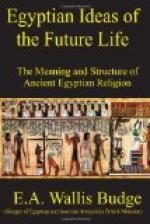who, if he got the better of Orus in the war wherein
they were going to be engaged, distracted by this
multiplicity of Sepulchres, might despair of being
able to find the true one—we are told moreover,
that notwithstanding all her search, Isis was never
able to recover the member of Osiris, which having
been thrown into the Nile immediately upon its separation
from the rest of the body, had been devoured by the
Lepidotus, the Phagrus, and the Oxyrynchus, fish which
of all others, for this reason, the Egyptians have
in more especial avoidance. In order however
to make some amends for the loss, Isis consecrated
the Phallus made in imitation of it, and instituted
a solemn festival to its memory, which is even,
to this day observed by the Egyptians.
“After these things, Osiris returning from the other world, appeared to his son Orus, encouraged him to the battle, and at the same time instructed him in the exercise of arms. He then asked him, ’what he thought was the moat glorious action a man could perform?’ to which Orua replied, ’to revenge the injuries offered to his father and mother.’ He then asked him, ’what animal he thought most serviceable to a soldier?’ and being answered ‘a horse’; this raised the wonder of Osiris, so that he farther questioned him, ’why he preferred a horse before a lion?’ because, adds Orus, ‘tho’ the lion be the more serviceable creature to one who stands in need of help, yet is the horse [Footnote: The horse does not appear to have been known in Egypt before the XVIIIth dynasty; this portion of Plutarch’s version of the history of Osiris must, then, be later than B.C. 1500.] more useful in overtaking and cutting off a flying adversary.’ These replies much rejoiced Osiris, as they showed him that his son was sufficiently prepared for his enemy—We are moreover told, that among the great numbers who were continually deserting from Typho’s party was his concubine Thueris, and that a serpent pursuing her as she was coming over to Orus, was slain by her soldiers—the memory of which action, say they, is still preserved in that cord which is thrown into the midst of their assemblies, and then chopt into pieces—Afterwards it came to a battle between, them which lasted many days; but victory at length inclined to Orus, Typho himself being taken prisoner. Isis however, to whose custody he was committed, was so far from putting him to death, that she even loosed his bonds and set him at liberty. This action of his mother so extremely incensed Orus, that he laid hands upon her, and pulled off the ensign of royalty which she wore on her head; and instead thereof Hermes clapt on an helmet made in the shape of an oxe’s head—After this, Typho publicly accused Orus of bastardy; but by the assistance of Hermes (Thoth) his legitimacy was fully established by the judgment of the Gods themselves—After this; there were two other battles fought between them, in both of which Typho had the worst. Furthermore, Isis is said to have accompanied with




